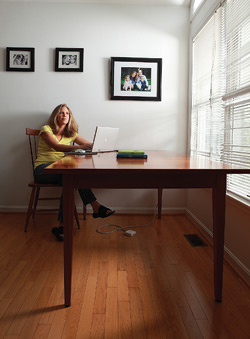 I really do believe in fate.
I really do believe in fate.
One of those very Godly encounters happened last month, when Jennifer Mendelsohn, an accomplished freelance writer and blogger, was randomly assigned to write an article about my work for Baltimore magazine. This astute journalist not only quizzed me, but interrogated a few of my co-workers and friends to get the real scoop on what Beyond Blue was all about.
When I read the finished piece I was crying and I sent her flowers. It was like one of those retreats, when your family and friends all write letters, but you don’t know about it until someone hands you a collection of letters. And you find out how much you mean to them, despite their making you feel like you really don’t.
The piece couldn’t have come at a better time, as I needed a reminder of my mission and why I write: not to sell thousands of books or to be most popular blogger in the mental health world, but to offer hope to those without any, and to try to shed light in the darkest, scariest corners of our homes.
A big thanks to Jennifer for all her work in writing this piece. And a humongous thanks to you all for your affirming, compassionate comments, without which I would never have the courage to publicly profess my whackjobness.
I’ve posted the first part of the piece and included a link for you to read the rest. (I didn’t want to get sued by the magazine for copyright infringement after they did me such a huge favor.)
When she’s seated next to a stranger on a plane, Therese Borchard of Annapolis is often asked what she does for a living. “Well, I write a mental health blog,” Borchard explains.
“How did you get into that?” goes the next question, typically. “Are you a therapist?”
Borchard’s answer is always the same.
“No,” she says straightforwardly. “I’m a patient.”
Borchard, 39, has bipolar disorder, an illness that has twice caused her to be hospitalized and remains an omnipresent–and sometimes agonizing–part of her days.
“When I get up in the morning, the first thing I think about when I open my eyes is ‘What’s my mood?'” she explains, sipping decaf from a Muppets mug in the dining room of the airy Eastport home she shares with her husband, architect and Annapolis native Eric Borchard, their son David, 8, daughter Katherine, 6, and two dogs. “I hope to get to the point where I think about coffee. But for right now, I work at it every day. I have to.”
Since late 2006, Borchard, a seasoned freelance writer and editor, has focused her formidable professional energies on her illness, regularly writing about depression for several media outlets. Her blog, Beyond Blue has become one of Beliefnet.com’s most popular. The blog (http://blog.beliefnet.com/beyondblue), which is updated two to four times a day, is a blend of Borchard’s accounts of her own day-to-day experiences, as well as interviews, practical advice for patients, and news items. January marked the release of Borchard’s memoir, “Beyond Blue: Surviving Depression & Anxiety and Making the Most of Bad Genes.” And in April Borchard published a second book, entitled “The Pocket Therapist: An Emotional Survival Kit,” a collection of what she calls her “sanity tools,” 144 pithy emotional survival strategies gleaned from her years and years–an estimated $40,000 worth–of therapy.
With her camera-friendly, girl-next-door charm, Borchard, a blue-eyed blonde with an easy laugh, has done much to counteract the antiquated but persistent stereotypes of the mentally ill, an important step in reducing the still very real stigma that surrounds them. On her book tour, some local radio personalities still voiced surprise that she didn’t “look crazy.”
“I would have to say, ‘Yeah, well it’s not the woman waiting for the city bus with the drool,'” explains Borchard. “Not that I’m a model or attractive, but I do look pretty average, normal. And I do think that’s important for people to see somebody who looks like a normal mom really struggling.”
Click here to continue reading.
Photo by David Rehor.

